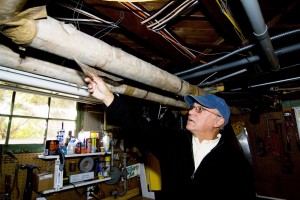Hazards that might be found in your house

Safe as houses? Maybe not. In fact, your house can be quite a dangerous place.
If you’ve ever purchased a home, you likely had a thorough inspection to reassure you not only about its structural condition, but also many other potential hazards like outdated wiring or termite damage.
But not every danger lurking in the home comes within the purview of a home inspection. And some hazards are invisible.
The health risks associated with pesticide use are well documented, but other imperceptible toxins found in the home may surprise you.
Take flame retardants, for example. These lifesavers have a not-so-good side, namely the polybrominated diphenyl ethers (PBDEs) found in many consumer plastics. Although two forms of PBDEs were phased out of use in 2004 after animal studies found they may be carcinogenic, the products that contain them are still around in many homes.
Toxic pollutants produced by cleaning solutions and air fresheners, too, have been well documented by the Environmental Protection Agency (EPA). And an Australian study found that some laser printers give off ultra-fine toxic particles.
Those are just some of the dangers that may be floating in the air. Others may emanate from the walls, the floors and even the closets.
If you own an older home, you may be living with Brady Bunch-era wood paneling consisting of wood particle products held together with a toxic resin called urea-formaldehyde, estimated by the EPA as the largest source of formaldehyde emissions indoors.
Consumer Reports recently advised that the glue and dyes used in new carpeting emit volatile organic compounds (VOCs) which are harmful to health in large concentrations.
And if you swear by mothballs, try not to inhale too much of the vapor, as some mothballs emit paradichlorobenzene, a known carcinogen in animals, according to the EPA. Other mothball brands emit naphthalene, which can destroy red blood cells, says the Centers for Disease Control.
But there are some invisible issues you might worry about unnecessarily, according to home inspector and structural engineer Joe Fischetti of Southold.
“We don’t need to be concerned about radon gas out here,” he said. “The levels are too low to warrant investigation.”
As far as visible hazards are concerned, though, there are definitely some worth noting.
“Asbestos, which is virtually ubiquitous in any home built before World War II, is dangerous if you start moving it,” observed Mr. Fischetti. “You find asbestos on old heating pipes. You can wrap them. It’s called encapsulation and it’s one way of dealing with it because you should not breathe it in. And those pipes are often located directly above the laundry machines and you certainly don’t want asbestos dropping into the wash.”
But, he says, there may be some conditions in the home that are dangerous only to certain kinds of occupants.
“Lead paint is a good example,” said Mr. Fischetti. “Some people call me and say they want to test for lead paint. If your house was constructed prior to 1976, you should assume there’s going to be lead paint.”
Mr. Fischetti acknowledges lead paint is toxic, but he puts it generally low on the list of household hazards unless there are small children living in the home. If there are toddlers around, he suggests being extra careful with the vacuum cleaner.
“If you knock a paint chip onto the floor, a small child might eat it,” he warned.
Generally speaking, though, he says lead paint is not something to worry about unless or until you renovate.
At the other end of the age spectrum, Mr. Fischetti suggests checking on the status of a home’s handrails.
“They’re missing in some older homes because they weren’t required back then,” he said. “But that could be a danger for older people along with tripping hazards.”
Mold is something that Mr. Fischetti does not see as a major problem either, except for older people or others whose immune systems may be compromised. Which is not to say you should ignore it if you have it.
“I’ve seen serious black mold that resulted from a small leak that was just never properly repaired,” he said.
But if your household comprises young adults with no children, Mr. Fischetti is quite sanguine about the impact of most domestic hazards.
He said, “In my opinion, nothing’s really dangerous for that group except maybe strong drink!”



